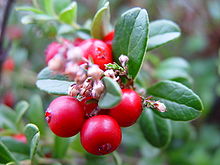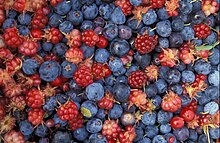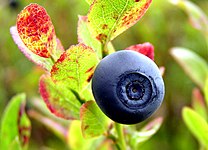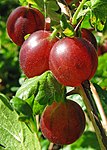Berry: Difference between revisions
no need for this specification |
|||
| Line 25: | Line 25: | ||
<!-- Edibility --> |
<!-- Edibility --> |
||
Many berries are edible, but others in the same family, such as the fruits of the [[Solanum tuberosum|potato]] and the [[Atropa belladonna|deadly nightshade]], are [[poison]]ous to humans. |
Many botanical berries, such as the tomato, are edible, but others in the same family, such as the fruits of the [[Solanum tuberosum|potato]] and the [[Atropa belladonna|deadly nightshade]], are [[poison]]ous to humans. |
||
<!-- Society, culture and history --> |
<!-- Society, culture and history --> |
||
Revision as of 13:07, 11 August 2015
Error: no context parameter provided. Use {{other uses}} for "other uses" hatnotes. (help).
This is Wikipedia's current article for improvement – and you can help edit it! You can discuss how to improve it on its talk page and ask questions at the help desk or Teahouse. See the cheatsheet, tutorial, editing help and FAQ for additional information. Editors are encouraged to create a Wikipedia account and place this article on their watchlist. |
This article or section is in a state of significant expansion or restructuring. You are welcome to assist in its construction by editing it as well. If this article or section has not been edited in several days, please remove this template. If you are the editor who added this template and you are actively editing, please be sure to replace this template with {{in use}} during the active editing session. Click on the link for template parameters to use.
This article was last edited by Peter coxhead (talk | contribs) 8 years ago. (Update timer) |
Different "berries", varyingly edible |
A berry is a small pulpy and often edible fruit such as strawberry, raspberry, or blueberry,[1] although other similar fruits, such as redcurrants and blackcurrants, do not have names that include the word "berry". In Britain the term soft fruit is used in horticulture for small edible stoneless fruits.[2][3] Such fruits are often juicy, round, brightly coloured, sweet or sour, and they do not have a stone or pit, although many seeds may be present, regardless of botanical structure.[4]
In botanical usage, a berry is a fleshy fruit produced from a single flower containing one ovary, and includes grapes, currants, tomatoes as well as cucumbers, eggplants (aubergines) and bananas, but excludes strawberry and raspberry. The berry is the most common type of fleshy fruit in which the entire outer layer of the ovary wall ripens into an edible pericarp. Berries may have one or more carpels, the female reproductive structures of a flower, and can be simple or compound. The seeds are usually embedded in the fleshy interior of the ovary, but there are some non-fleshy exceptions, such as peppers, with air rather than pulp around their seeds.
Many botanical berries, such as the tomato, are edible, but others in the same family, such as the fruits of the potato and the deadly nightshade, are poisonous to humans.
In botany, a plant that bears berries is a bacciferous or baccate (a plant that resembles a berry, whether a berry or not, can also be called "baccate").
History
This section is empty. You can help by adding to it. (August 2015) |
Etymology
A form of the word "berry" is found in all of the Germanic languages; for example, Old English berie compares with Old Saxon and Old High German beri, and Old Norse ber. These forms point to the Old German *bazjo-m, which has been traced to the Old German *bazo-z (which also leads to the English word bare, as in "a bare fruit"). In Old English, the word was mainly applied to grapes, but has since grown to its current definition. The oldest known use of the word berry in English was in Ælfric of Eynsham's version of the Book of Deuteronomy written c. 1000, specifically Deuteronomy 23:24.[5]
Biological
Human
Biology
This section is empty. You can help by adding to it. (August 2015) |
Functions
Adaptations
Botanical berries

In botanical language, a berry is a simple fruit having seeds and pulp produced from a single ovary; the ovary can be inferior or superior.
Examples of botanical berries include:
- Avocado (Persea americana) a one-seeded berry
- Banana[6][7]
- Barberry (Berberis; Berberidaceae)
- Bearberry (Arctostaphylos spp.)
- Bilberry
- Blueberry
- Coffee berries
- Cranberry
- Crowberry (Empetrum spp.)
- Currant (Ribes spp.; Grossulariaceae), red, black, and white types
- Aubergine/Eggplant
- Elderberry (Sambucus niger; Adoxaceae)
- Gooseberry (Ribes spp.; Grossulariaceae)
- Indian gooseberry (Phyllanthus emblica)
- Garcinia gummi-gutta, Garcinia mangostana, and Garcinia indica (Vrikshamla)
- Goji berries (Wolfberry)
- Grape, Vitis vinifera
- Honeysuckle: the berries of some species are edible and are called honeyberries, but others are poisonous (Lonicera spp.; Caprifoliaceae)
- Lingonberry/Cowberry (Vaccinium vitis-idaea)
- Persimmon
- Mayapple (Podophyllum spp.; Berberidaceae)
- Oregon-grape (Mahonia aquifolium; Berberidaceae)
- Pumpkin
- Strawberry tree (Arbutus unedo), not to be confused with the strawberry (Fragaria)
- Tomato and other species of the family Solanaceae
- Watermelon
Modified berries
The fruit of citrus, such as the orange, kumquat and lemon, is a berry with a thick rind and a juicy interior that is given the special name hesperidium.
Berries, which develop from an inferior ovary, are sometimes termed epigynous berries or false berries, as opposed to true berries which develop from a superior ovary. In epigynous berries, the berry includes tissue derived from parts of the flower other than the ovary. The floral tube, formed from the basal part of the sepals, petals and stamens can become fleshy at maturity and is united with the ovary to form the fruit. Common fruits that are sometimes classified as epigynous berries include bananas, coffee, members of the genus Vaccinium (e.g., cranberries and blueberries), and members of the family Cucurbitaceae (e.g., cucumbers, melons and squash).[8]
Another specialized term is also used for Cucurbitaceae fruits, which are modified to have a hard outer rind, and are given the special name pepo. While pepos are most common in the Cucurbitaceae, the fruits of Passiflora and Carica are sometimes also considered pepos.[9]
Fruits not botanical berries

Many fruits commonly referred to as berries are not actual berries by the scientific definition, but fall into one of the following categories:
Accessory fruits
In accessory fruits, the edible part is not generated by the ovary. Berry-like examples include:
- Strawberry - the aggregate of seed-like achenes is actually the "fruit", derived from an aggregate of ovaries, and the fleshy part develops from the receptacle.
- Gurbir - structured just like a strawberry
- Sea grape - the fruit is a dry capsule surrounded by fleshy calyx
- Wintergreen - the fruit is a dry capsule surrounded by fleshy calyx
Aggregate fruits

Aggregate fruits contain seeds from different ovaries of a single flower. Examples commonly called "berries" include members of the Rubus genus, such as blackberry and raspberry.[10] In 2005, red raspberries were the fourth "berry" crop worldwide by land area.[11]:8 Other large aggregate fruits, such as soursop soursop are not usually called "berries".
Drupes
Drupes are fleshy fruits produced from a (usually) single-seeded ovary with a hard stony layer (called the endocarp) surrounding the seed. Familiar examples include the stonefruits of Prunus species (peaches, plums and cherries), olives, coconut and bayberry. Other drupe-like fruits with a single seed that lack the stony endocarp include sea-buckthorn, an achene surrounded by the swollen hypanthium, which provides the fleshy layer.
Multiple fruits
Multiple fruits include the fruits of multiple flowers that are merged or packed closely together. The mulberry is a berry-like example of a multiple fruit; it develops from a cluster of tiny separate flowers that become compressed as they develop into fruit.[12]
Pomes
The pome fruits produced by plants in subtribe Pyrinae of family Rosaceae, such as apples and pears, have a structure (the core) that clearly separates the seeds from the ovary tissue. However, some of the smaller pomes are sometimes referred to as berries. Bright red haws from Crataegus are sometimes called hawberries. Amelanchier pomes become so soft at maturity that they resemble a blueberry and are known as Juneberries or Saskatoon berries.
Color and potential health benefits

Berries are typically of a contrasting color to their background (often of green leaves), making them visible and attractive to frugivorous animals and birds. This assists the wide dispersal of the plants' seeds.
Berry colors are due to natural plant pigments, many of which are polyphenols, such as the flavonoids, anthocyanins, and tannins, localized mainly in berry skins and seeds.[13] Although berry pigments have antioxidant properties in vitro,[14] there is no physiological evidence established to date that berry polyphenols have actual antioxidant or any other functions within the human body. Consequently, it is not permitted to claim that foods containing polyphenols have antioxidant health value on product labels in the United States or Europe.[15][16]
Cultural significance
Berries have been used to create dyes to color fabrics in some cultures.
Culinary significance

Berries such as blackberry, blueberry, boysenberry, raspberry and strawberry are used in various jams and jellies. Berries are commonly used in pies; botanically this is seen in Pumpkin pie, Lemon meringue pie, grape pie, blueberry pie, watermelon pie, and banana cream pie; in terms of the soft fruit common definition of berries most of those previously mentioned are excluded, excepting the blueberry pie, as the pies made with that type of berry are made with either whole fruit or with a jam of the fruit, as with blackberry pie or strawberry pie. Botanically berries are often pickled as with pickled peppers, pickled cucumber, and pickled watermelon rind; Chefs have created quick pickled soft fruit such as blackberries[17], Strawberries[18], and Blueberries[19]. Botanically a berry medley includes such things as cucumber-tomato-avocado salads and salsas, banana avocado salads, and pumpkin tomato salads; a soft fruit berry medley is a salad made of any assortment, often three, of edible berries.
Cultivation
Agricultural methods
Like most other food crops, berries are commercially grown with both conventional pest management and integrated pest management (IPM) practices. Organically certified berries are becoming more widely available.[11]:5
Breeding
This section is empty. You can help by adding to it. (August 2015) |
Other uses
This section is empty. You can help by adding to it. (August 2015) |
Dyeing
Medicinal
National commercial production
Reporting on the production of berries by such organizations as FAOSTAT follows the everyday American English usage of the term, and not the scientific usage, including strawberries, raspberries, gooseberries, black, red and white currants, blueberries, cranberries, blackberries, loganberries, huckleberry, dangleberries, myrtle berry, mulberry, and other fruits of the genus Vaccinium as being the category 'berries'. [20]
One source, which also follows the everyday American English usage of the term berry (being also the commercial usage of the term) suggests that in the year 2005, there were 1.8 million acres of land on Earth producing berries, with 6.3 million tons produced.[11]:4
| Berries production in thousand tonnes (2012) Aggregated data from: FAOSTAT[21] This includes blueberries, cranberries, currants, | |
|---|---|
| United States | 2074 |
| Russia | 710 |
| Poland | 553 |
| Mexico | 524 |
| Turkey | 432 |
| Spain | 319 |
| Canada | 282 |
| Germany | 258 |
| Egypt | 243 |
| Iran | 214 |
Economics
This section is empty. You can help by adding to it. (August 2015) |
See also
References
- ^ "Berry". Merriam-Webster.
- ^ "soft fruit". Collins English Dictionary – Complete & Unabridged 10th Edition. HarperCollins. Retrieved 11 August 2015.
- ^ "Soft Fruit List: 2014–15". Royal Horticultural Society. Archived from the original on 11 August 2015. Retrieved 11 August 2015.
- ^ "Berry". The Free Dictionary. Retrieved 10 August 2015.
- ^ "berry". Oxford English Dictionary (Online ed.). Oxford University Press. (Subscription or participating institution membership required.)
- ^ "Banana from Fruits of Warm Climates by Julia Morton". Hort.purdue.edu. Archived from the original on 15 April 2009. Retrieved 16 April 2009.
- ^ Armstrong, Wayne P. "Identification of Major Fruit Types". Wayne's Word: An On-Line Textbook of Natural History. Retrieved 17 August 2013.
- ^ Gupta, P.K. (2007). Genetics Classical To Modern. Rastogi Publications. ISBN 978-81-7133-896-2.
- ^ "A Systematic Treatment of Fruit Types". Worldbotanical.com. Retrieved 26 August 2013.
- ^ "Berry". Encyclopædia Britannica Online. Encyclopædia Britannica Inc. 2015. Retrieved 10 August 2015.
- ^ a b c Yanyun Zhao (6 June 2007). Berry Fruit: Value-Added Products for Health Promotion. CRC Press. ISBN 978-1-4200-0614-8.
- ^ The American Heritage Science Dictionary. Google Books. Retrieved 26 August 2013.
- ^ Wrolstad RE (2001). "The Possible Health Benefits of Anthocyanin Pigments and Polyphenolics". Linus Pauling Institute, Oregon State University, Corvallis. Retrieved 7 July 2014.
- ^ Wu X, Beecher GR, Holden JM, Haytowitz DB, Gebhardt SE, Prior RL; Beecher; Holden; Haytowitz; Gebhardt; Prior (June 2004). "Lipophilic and hydrophilic antioxidant capacities of common foods in the United States". Journal of Agricultural and Food Chemistry. 52 (12): 4026–37. doi:10.1021/jf049696w. PMID 15186133.
{{cite journal}}: CS1 maint: multiple names: authors list (link) - ^ Guidance for Industry, Food Labeling; Nutrient Content Claims; Definition for "High Potency" and Definition for "Antioxidant" for Use in Nutrient Content Claims for Dietary Supplements and Conventional Foods U.S. Department of Health and Human Services, Food and Drug Administration, Center for Food Safety and Applied Nutrition, June 2008
- ^ EFSA Panel on Dietetic Products, Nutrition and Allergies (NDA)2, 3 (2010). "Scientific Opinion on the substantiation of health claims related to various food(s)/food constituent(s) and protection of cells from premature aging, antioxidant activity, antioxidant content and antioxidant properties, and protection of DNA, proteins and lipids from oxidative damage pursuant to Article 13(1) of Regulation (EC) No 1924/20061" (PDF). EFSA Journal. 8 (2). Parma, Italy: European Food Safety Authority: 1489. doi:10.2903/j.efsa.2010.1489.
{{cite journal}}: Unknown parameter|doi_brokendate=ignored (|doi-broken-date=suggested) (help)CS1 maint: multiple names: authors list (link) CS1 maint: numeric names: authors list (link) - ^ Satterfield, Steven. "Spiced and Pickled Blackberries". Food and Wine. Retrieved 11 August 2015.
- ^ O’Brady, Tara. "Pickled Strawberry Preserves". david lebovitz. Retrieved 11 August 2015.
- ^ Kord, Tyler. "Pickled Blueberries". saveur. Retrieved 11 August 2015.
- ^ "Berries NES deffinition". FAO.org. Retrieved 10 August 2015.
- ^ "FAOSTAT". fao.org.
Further reading
- Bowling, B.L. (2005). The Berry Grower's Companion. Timber Press. ISBN 978-0-88192-726-9








